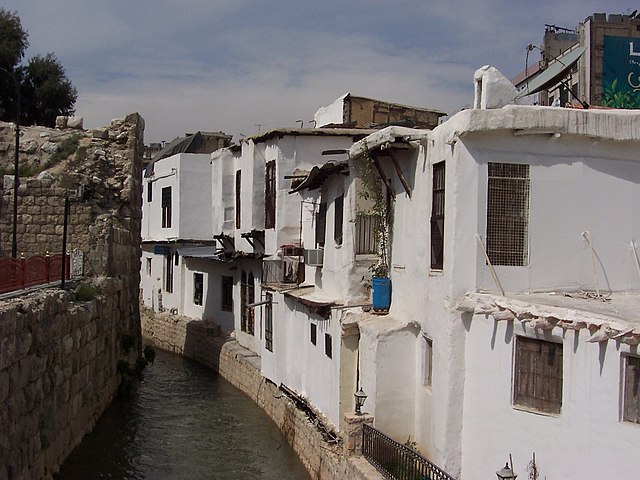Top Qs
Timeline
Chat
Perspective
Barada
River in Syria From Wikipedia, the free encyclopedia
Remove ads
The Barada (Arabic: بَرَدَىٰ / ALA-LC: Baradā) is the main river of Damascus, the capital city of Syria.
Remove ads
Etymology

The word "Barada" is thought to be derived from the word barid, which means "cold" in Semitic languages.[1] The ancient Greek name (Greek: Χρυσορρόας, romanized: Chrysorrhoas), means "streaming with gold".[2]
Topography and source
Summarize
Perspective
Throughout the arid plateau region east of Damascus, oases, streams, and a few minor rivers that empty into swamps and small lakes provide water for local irrigation. Most important of these is the Barada, a river that rises in the Anti-Lebanon Mountains and disappears into the desert. The Barada flows out of the karst spring of Ain al-Fijah, about 27 kilometres (17 mi) north west of Damascus in the Anti-Lebanon Mountains, but its true source is Lake Barada, a small lake that is also a karst spring located about 8 kilometres (5.0 mi) from Al-Zabadani. The Barada descends through a steep, narrow gorge named "Rabwe" before it arrives at Damascus, where it divides into seven branches that irrigate the Al Ghutah (الغوطة) oasis, the location of Damascus. Eventually the Ghouta reached a size of 370 square kilometers, although in the 1980s urban growth started replacing agricultural use with housing and industry.[3] The river has suffered from severe drought in recent decades, mainly due to the lower rainfall rates and the large increase in the population in the area.[4] It also suffers from serious pollution, especially in the summer, when there is almost no flow and little water in the basin.
Remove ads
Biblical mention
The Barada is identified as Abana (or Amana, in Qere and Ketiv variation in Tanakh and classical Chrysorrhoas), which is the more important of the two rivers of Damascus, Syria, and was mentioned in the Book of Kings (2 Kings 5:12). As the Barada rises in the Anti-Libanus and escapes from the mountains through a narrow gorge, its waters debouch fan-like, in canals or rivers, the name of one of which, the River Banias, retains a trace of Abana.[5]
John MacGregor, who gives a description of them in his book Rob Roy on the Jordan, affirms that as a work of hydraulic engineering the system and construction of the canals, by which the Abana and Pharpar were used for irrigation, might be considered as one of the most complete and extensive in the world. In the Bible, Naaman exclaims that the Abana and Pharpar are greater than all the waters of Israel.[5]
Branching
The Barada branches at the village of Hameh and the gorge of Rabweh into six distributaries or canals, two of which, Yazid and Tora, branch off the northern bank whilst the remaining four, Mezzawi, Derani, Qanawat and Banias, are formed from the southern bank.[6]
The Yazid canal runs north to the districts of Salihya and Qabun; Tora, the oldest of all, passes through the district of Al-Jisr Al-Abyad, heading to Jobar and Harasta; Mezzawi tears through Mezzeh; Derani runs towards Darya; Banias runs by the National Museum north of the Citadel and reaches Bab Touma; and finally the Qanawat canal pours into the southern quarters of the old city following Via Recta.[7]
Outside the city of Damascus, the water gathers to pour into the River Qleit, which runs to Eastern Ghouta.[7]
Remove ads
Gallery
- The upper valley of the Barada in the Anti-Lebanon Mountains 1855
- Barada river 1868
- Barada river around 1930
- Feeja Spring in 2007
- The dry riverbed Barada in August 2010
- Annotated view of Barada and Damascus with surroundings, as seen from space in 2013
See also
References
External links and further reading
Wikiwand - on
Seamless Wikipedia browsing. On steroids.
Remove ads








